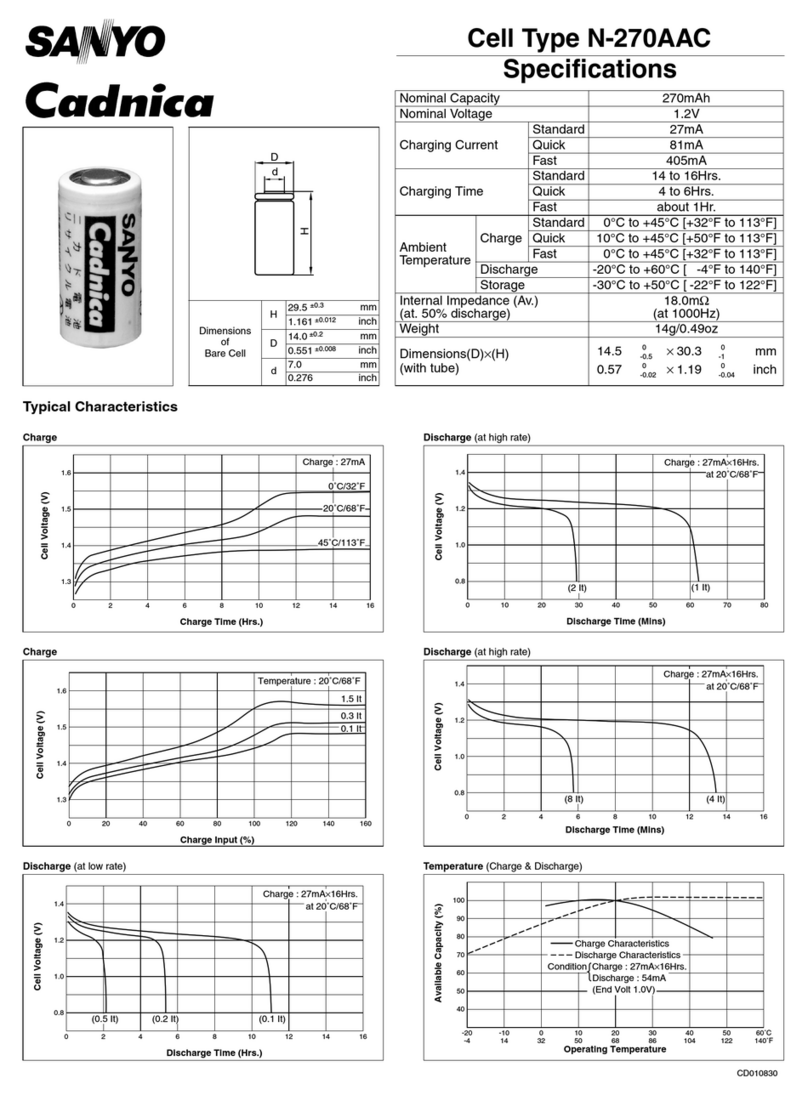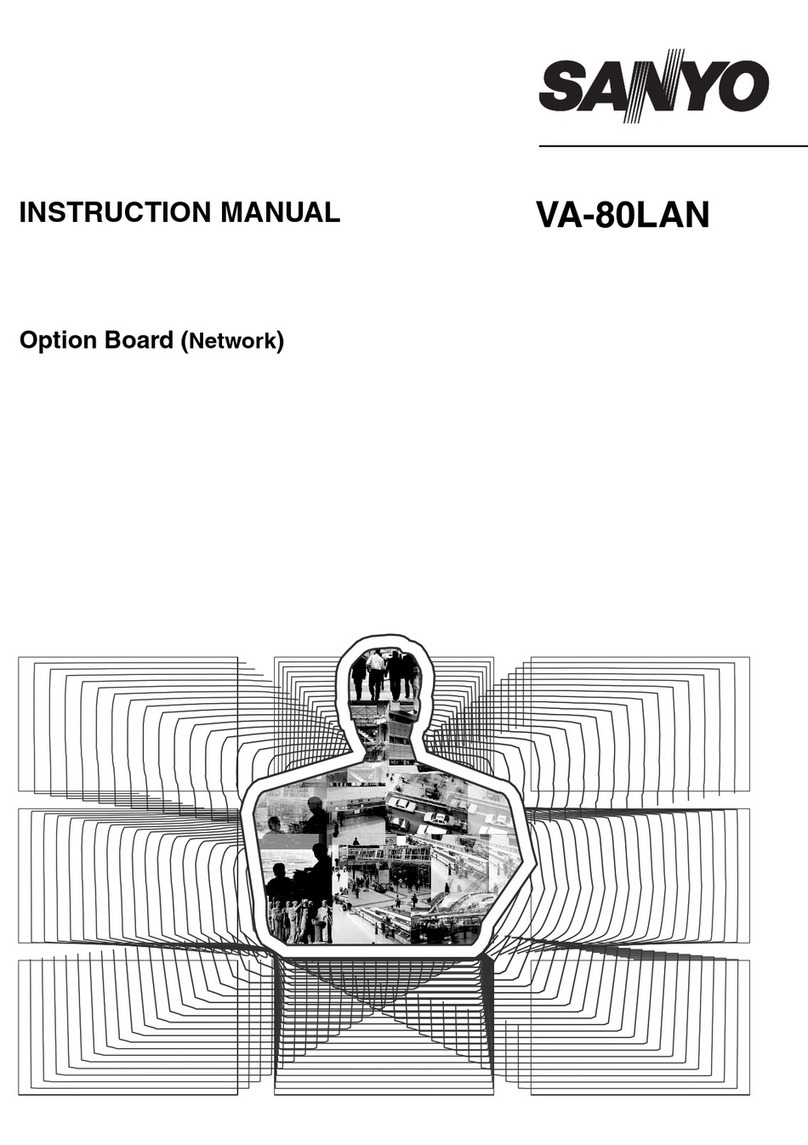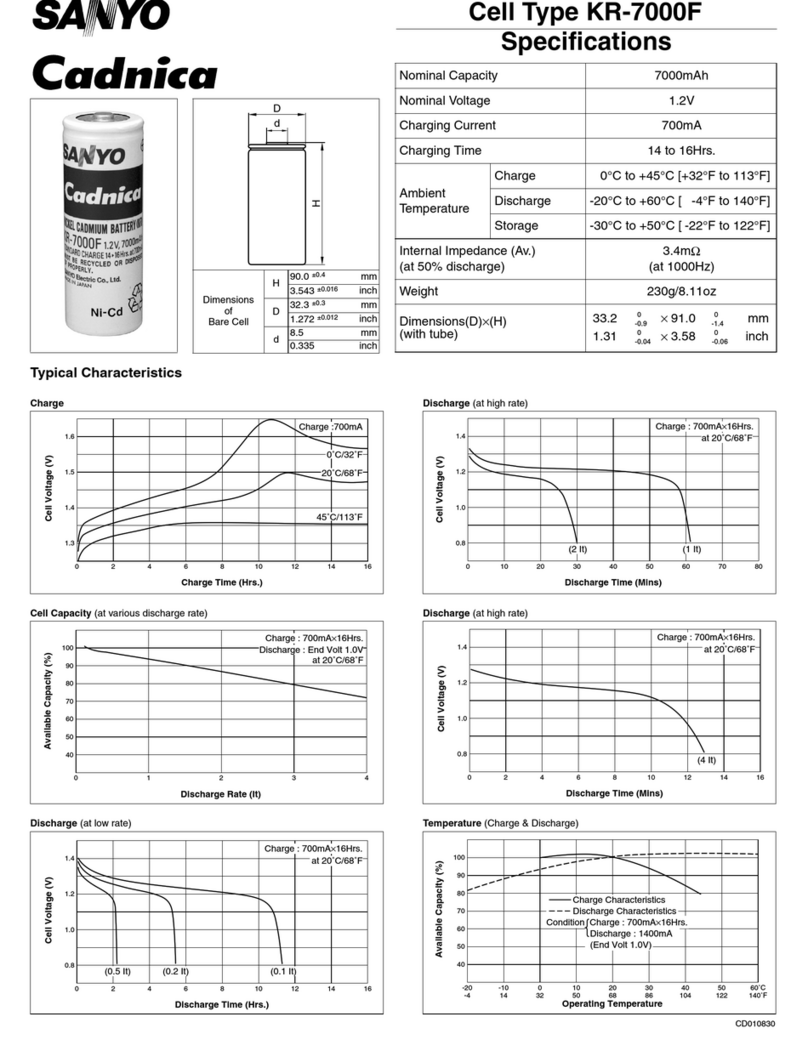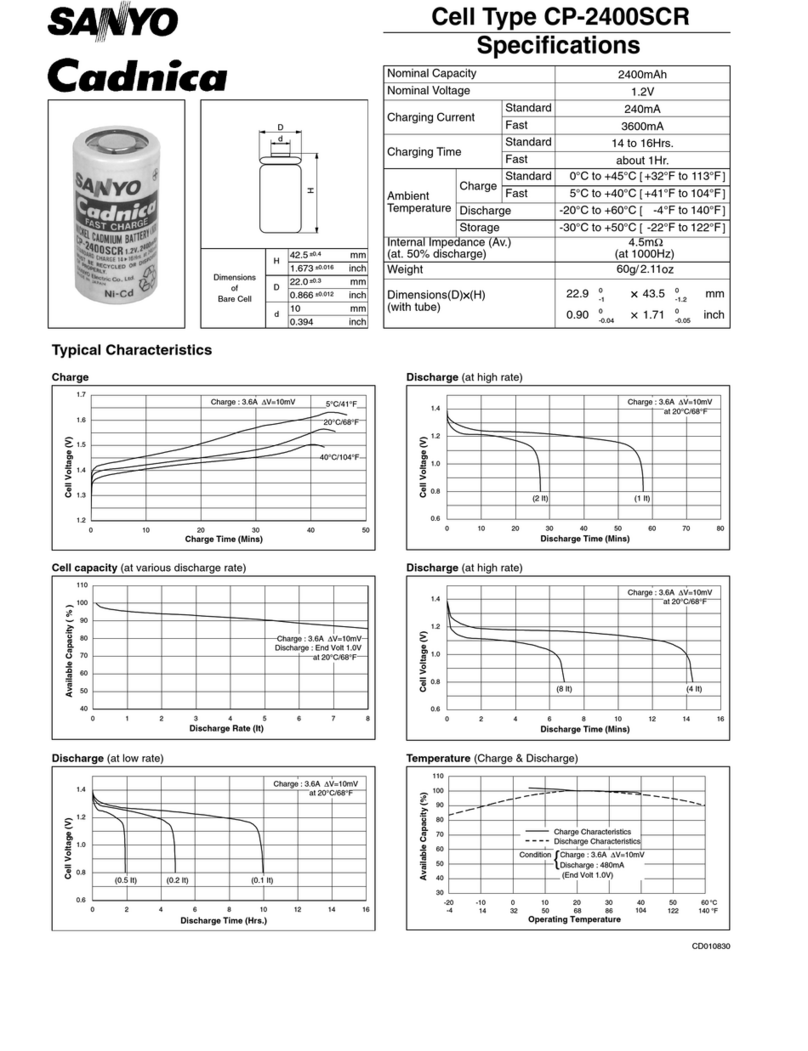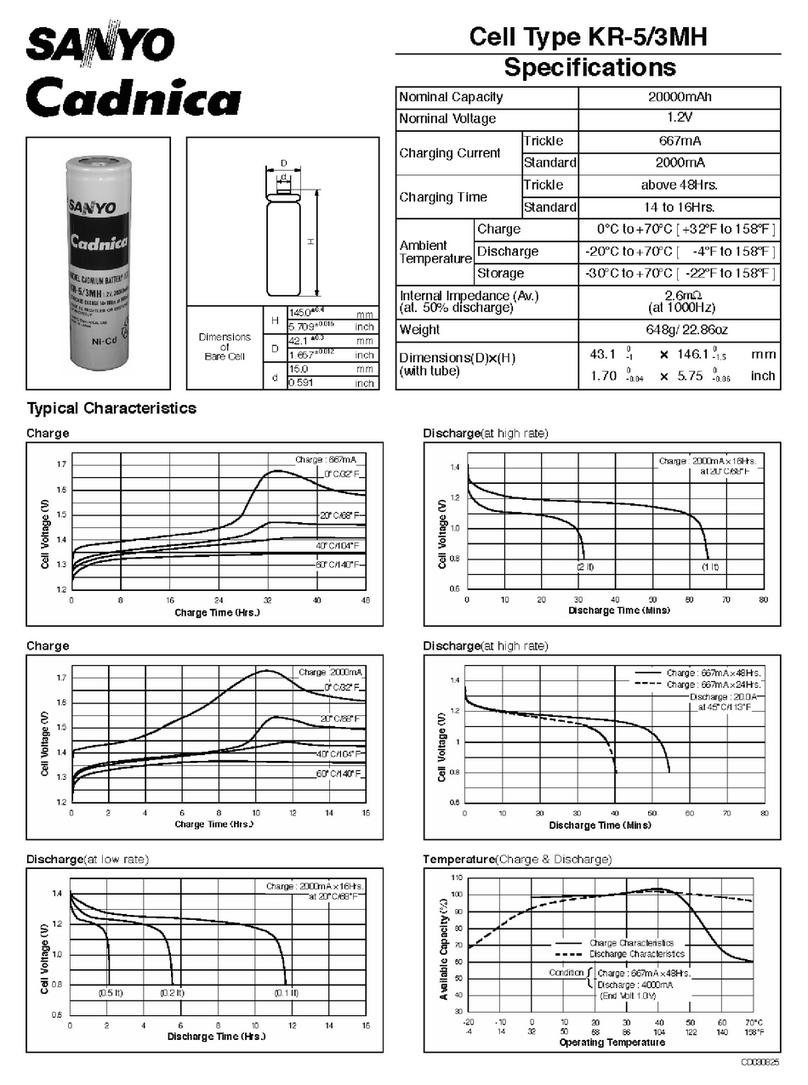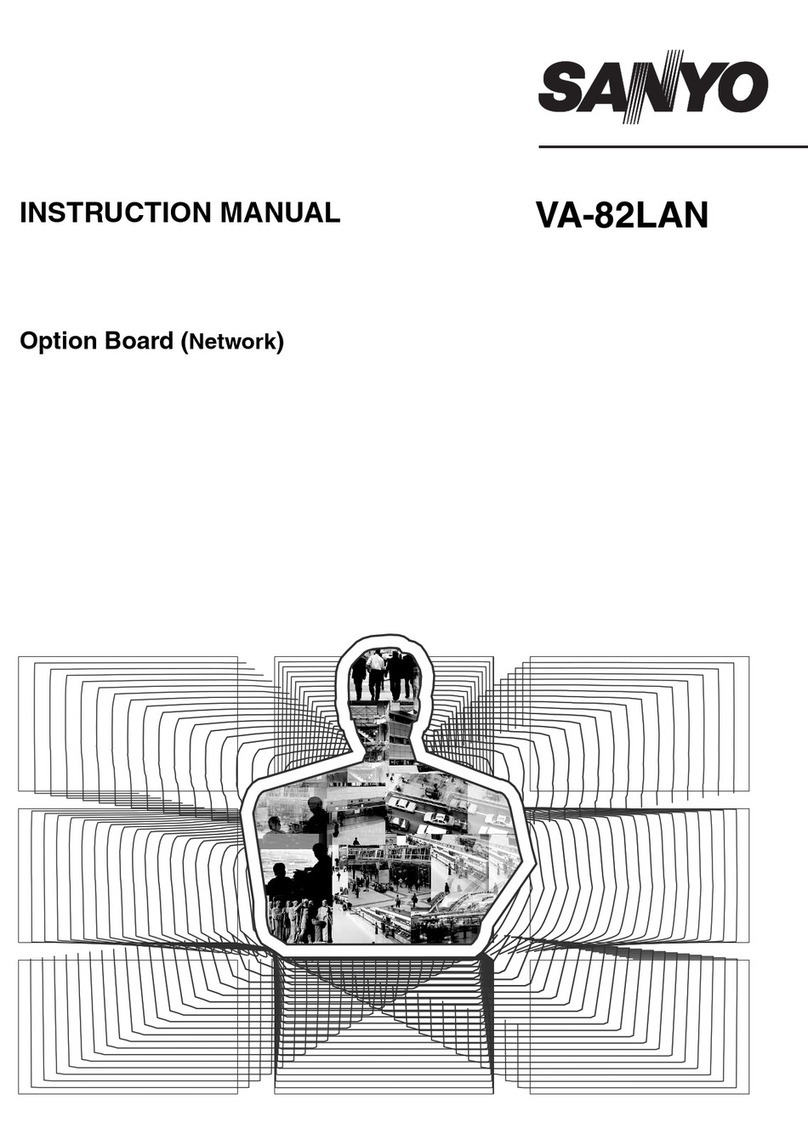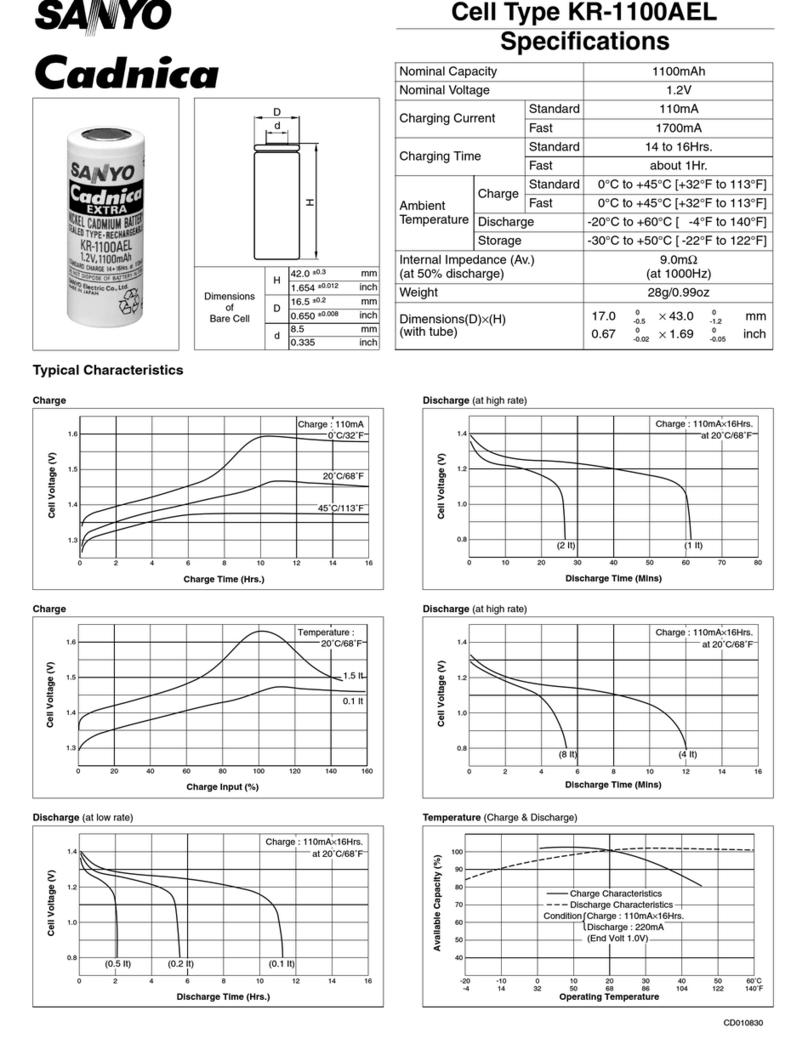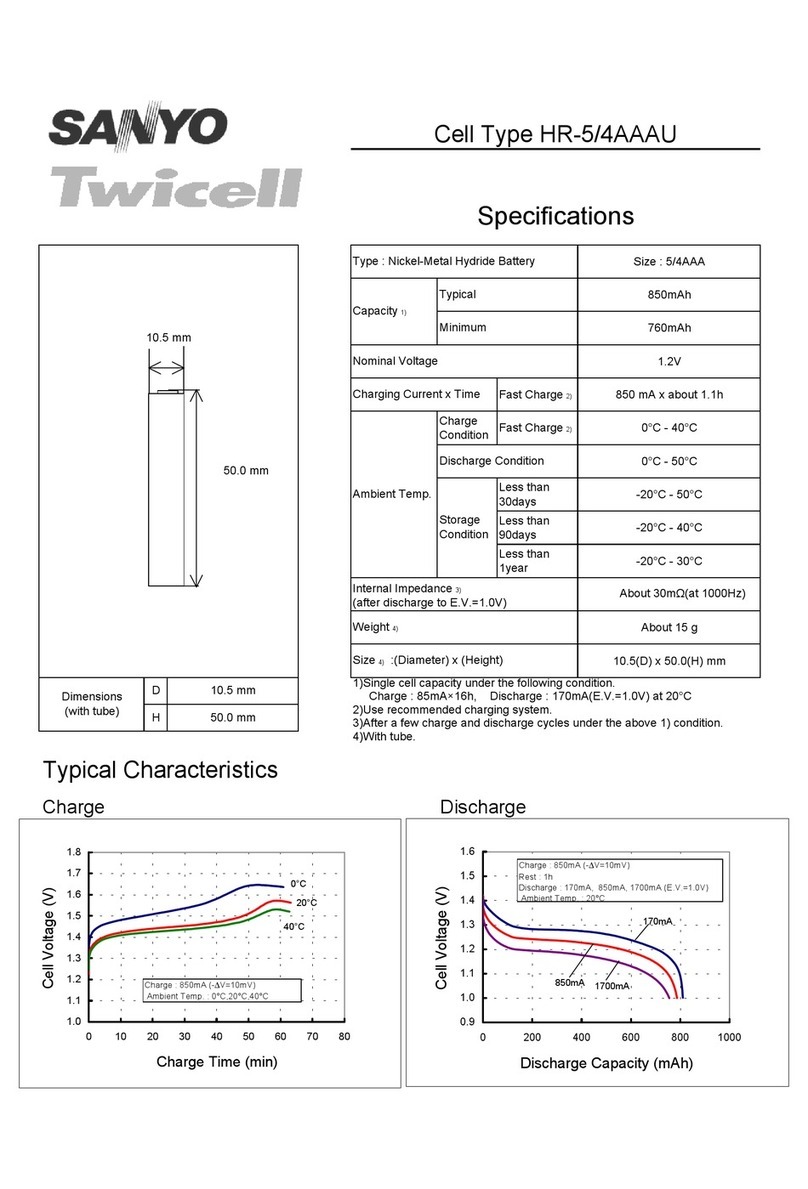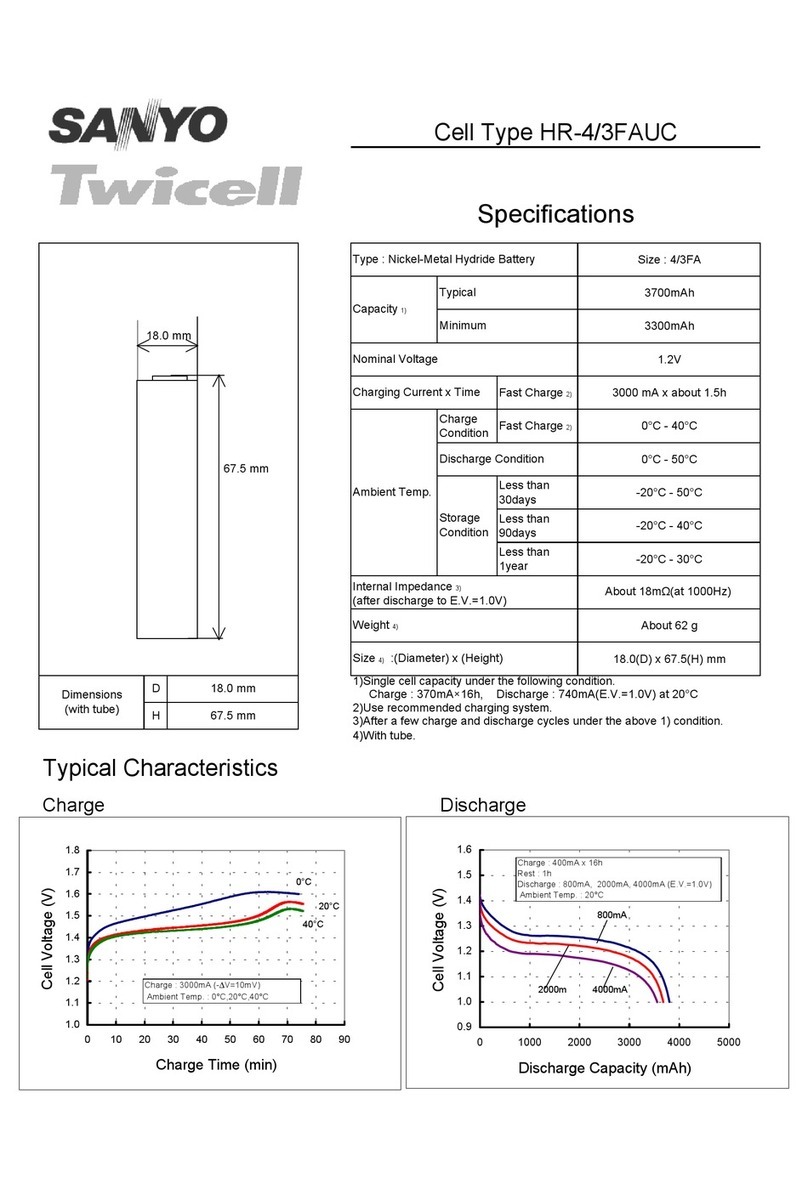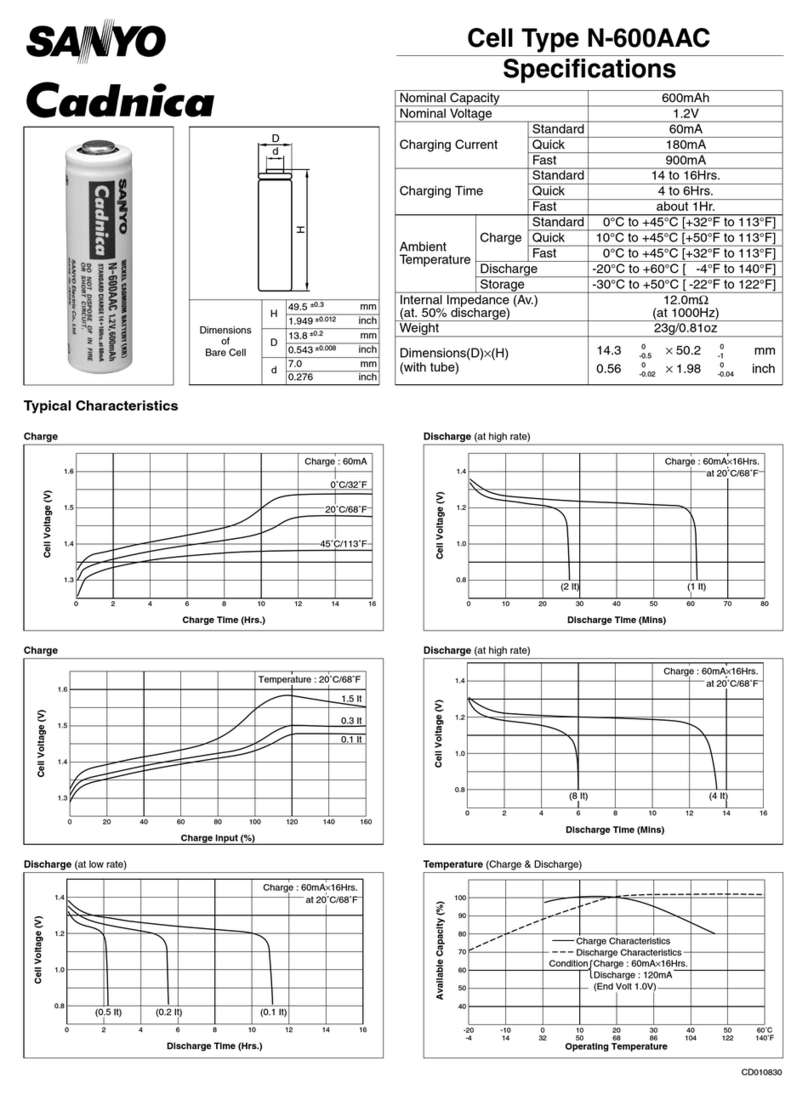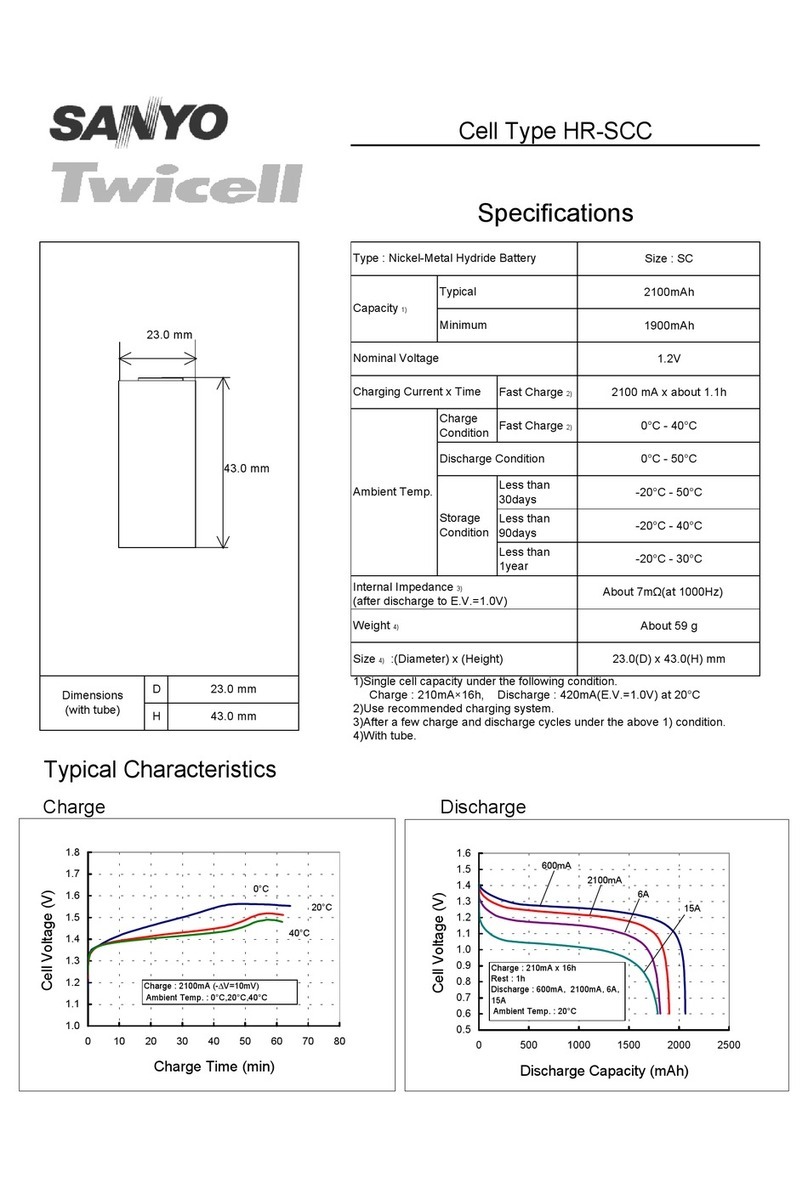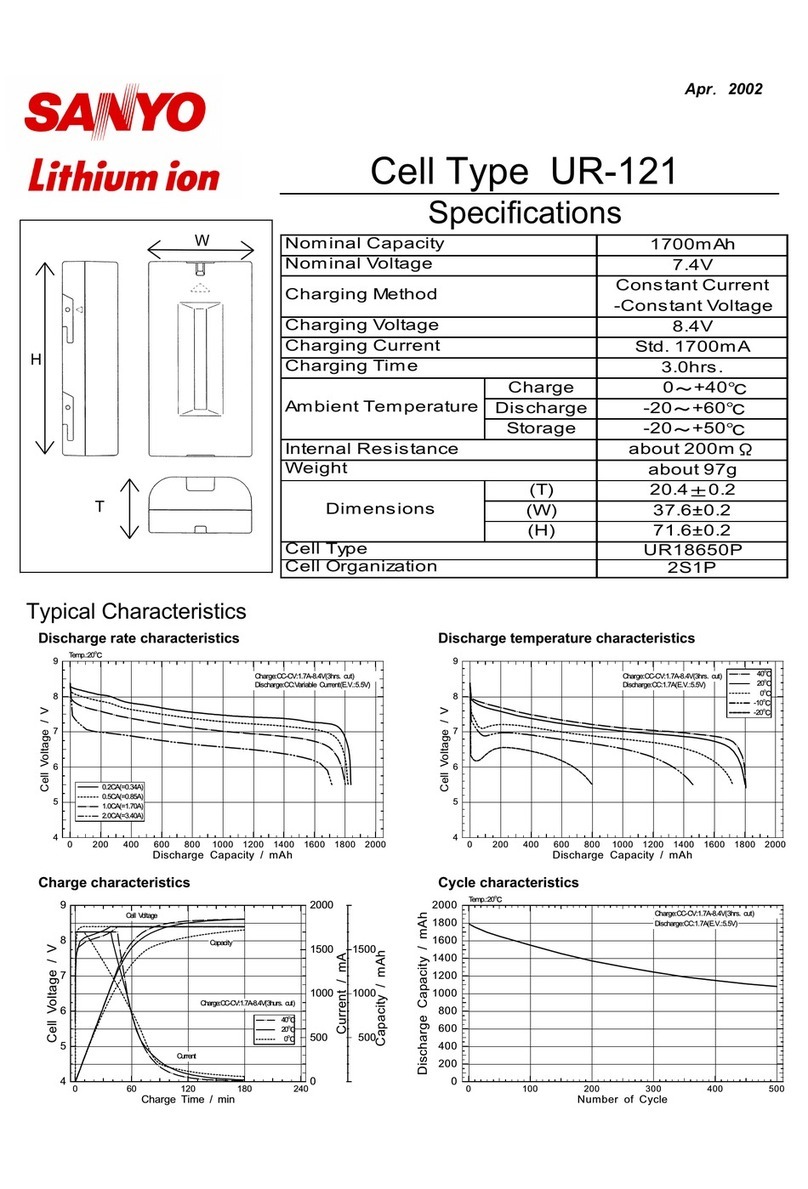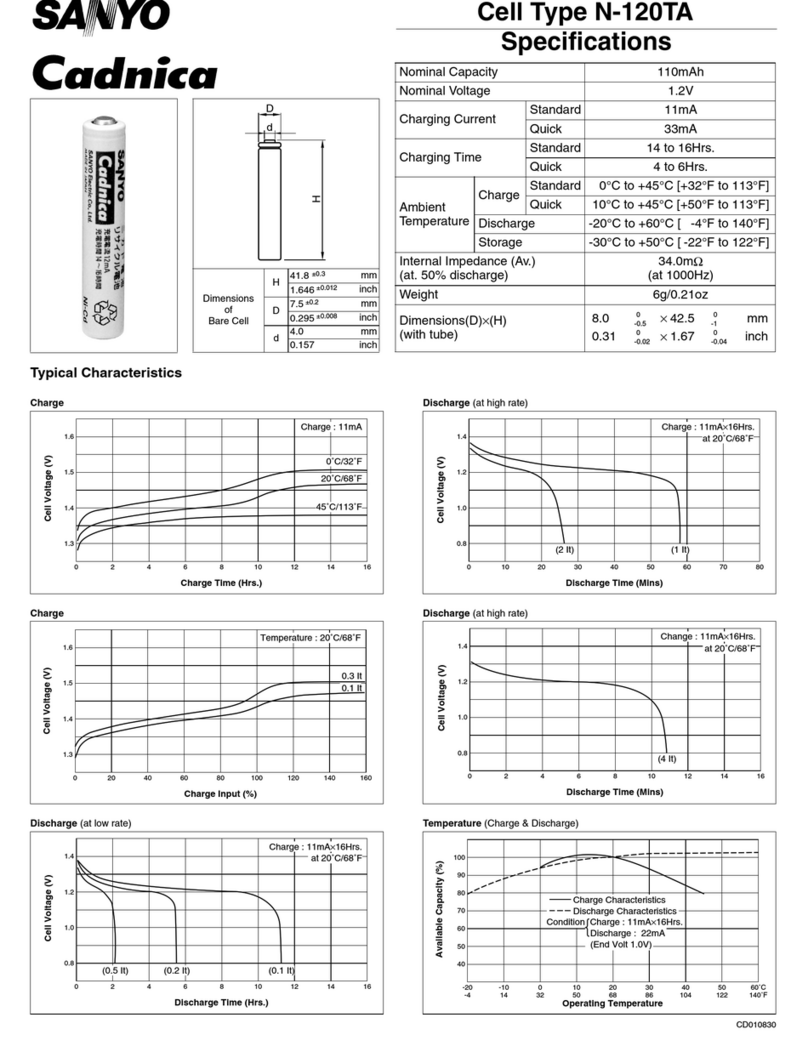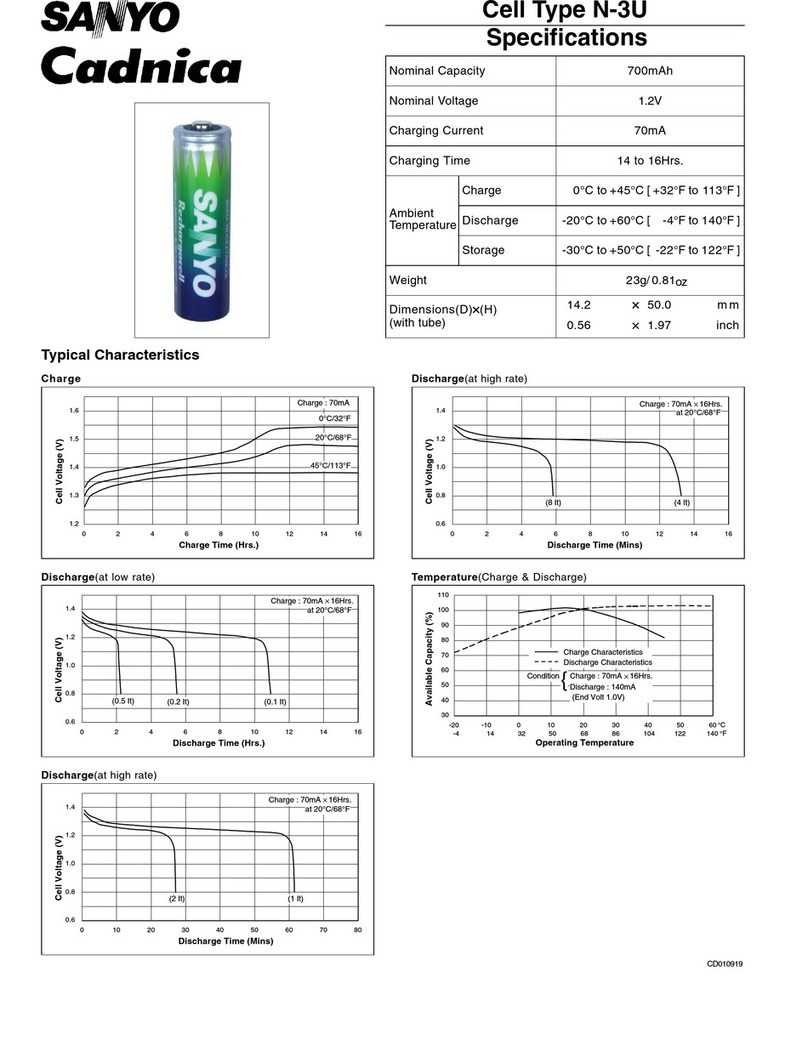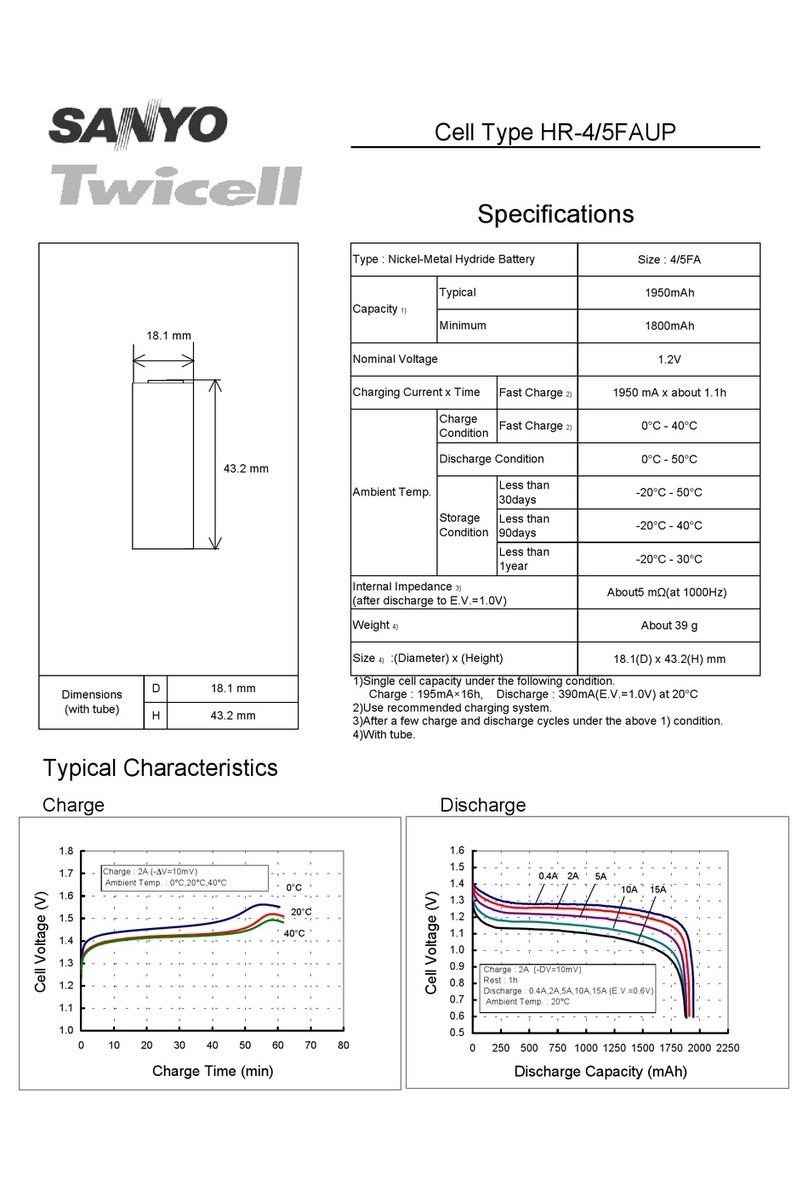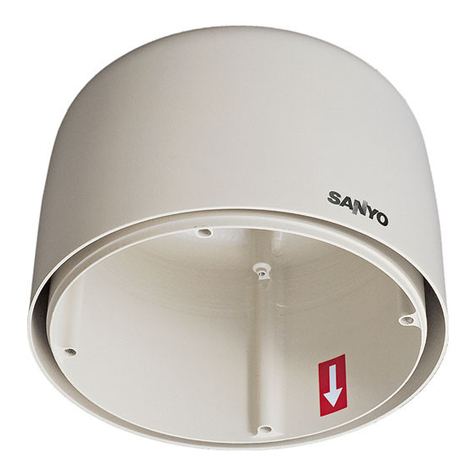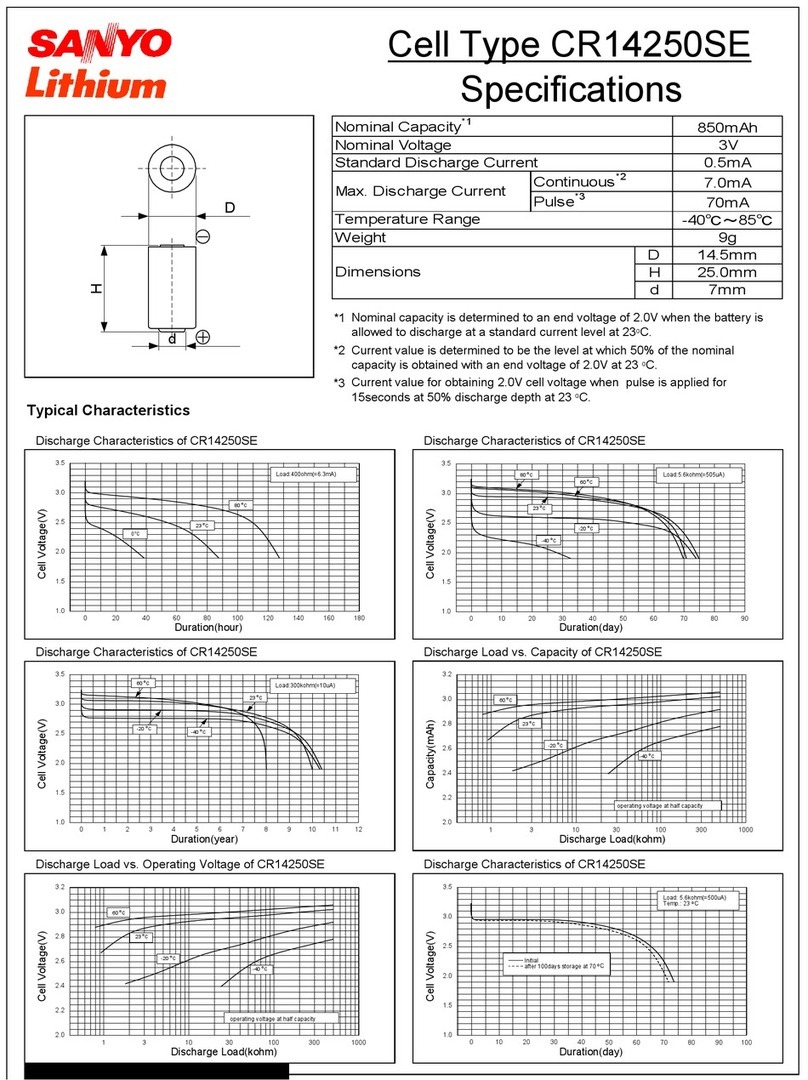
Lithium Polymer Battery Handling Precautions
1Do not disassemble or modify the battery pack. The battery pack is equipped with
built-in safety/protection features. Should these features be disabled, the battery
pack can damage, overheat, emit smoke, burst and/or ignite.
2Do not connect the positive (+) and negative (–) terminals with a metal object such
as wire. Do not transport or store the battery pack together with metal objects such
as necklaces, hair pins, etc. Otherwise, short-circuiting will occur, overcurrent will
flow, causing the battery pack to damage, overheat, emit smoke, burst and/or
ignite, or the metal object such as wire, necklace or hair pin can generate heat.
3Do not discard the battery pack into fire or heat it. Otherwise, its insulation can
melt down, safety features will be damaged and/or its electrolyte can ignite,
possibly leading to damage, overheating, smoke emission, bursting and/or ignition
on it.
4Do not use or leave the battery pack near a heat source such as fire or heater
(80°C or higher). If the resin separator should be damaged owing to overheating,
internal short-circuiting may occur to the battery pack, possibly leading to damage,
overheating, smoke emission, bursting and/or ignition of the battery pack.
5Do not immerse the battery pack in water or seawater, and do not allow it to get
wet. Otherwise, the protective features in it can be damaged, it can be charged
with extremely high current and voltage, abnormal chemical reactions may occur in
it, possibly leading to damage, overheating, smoke emission, bursting and/or
ignition.
6Do not recharge the battery pack near fire or in extremely hot weather. Otherwise,
hot temperatures can trigger its built-in protective features, inhibiting recharging, or
can damage the built-in protective features, causing it to be charged with an
extremely high current and voltage, and, as a result, abnormal chemical reactions
can occur in it, possibly leading to damage, overheating, smoke emission, bursting
and/or ignition.
7To recharge the battery pack, use the battery charger specifically designed for the
purpose and observe the recharging conditions specified by SANYO. A recharging
operation under non-conforming recharging conditions (higher temperature and
larger voltage/current than specified, modified battery charger, etc.) can cause the
battery pack to be overcharged, or charged with extremely high current, abnormal
chemical reaction can occur in it, possibly leading to damage, overheating, smoke
emission, bursting and/or ignition.
8Do not pierce the battery pack with a nail or other sharp objects, strike it with a
hammer, or step on it. Otherwise, the battery pack will become damaged and
deformed, internal short-circuiting can occur, possibly leading to damage,
overheating, smoke emission, bursting and/or ignition.
9Do not strike or throw the battery pack. The impact might cause damage,
overheating, smoke emission, bursting and /or ignition.And also if the protective
feature in it may become damaged, it will be charged with extremely high current
and voltage, abnormal chemical reactions can occur, possibly leading to damage,
overheating, smoke emission, bursting and /or ignition.
10 Do not use an apparently damaged or deformed battery pack. Otherwise, damage,
overheating, smoke emission, bursting and/or ignition of the battery pack may
occur.
11 Do not directly solder the battery pack. Otherwise, heat can melt down its
insulation, damage its gas release vent or safety features possibly leading to
damage, overheating, smoke emission, bursting and/or ignition.
12 Do not reverse the positive (+) and negative (–) terminals. Otherwise, during
recharging, the battery pack will be reverse-charged, abnormal chemical reactions
then may occur, or excessively high current can flow during discharging possibly
leading to damage, overheating, smoke emission, bursting and/or ignition.
13 The positive (+) and negative (–) terminals are arranged in a particular orientation.
Do not force the connection if you cannot easily connect the battery pack terminals
to the battery pack charger or other equipment. Confirm that the terminals are
correctly oriented. Reversing the terminals will result in reverse-charging, possibly
leading to damage, overheating, smoke emission, bursting and/or ignition of the
battery pack.
14 Do not connect the battery pack to an electrical outlet, vehicle cigarette lighter, etc.
Danger
Caution
Warning
1Do not use the battery pack in combination with primary battery packs (such as
dry-cell battery packs) or battery packs of different capacities or brands.
Otherwise, the battery pack can be overdischarged during use or overcharged
during recharging, abnormal chemical reactions may occur, possibly leading to
damage, overheating, smoke emission, bursting and/or ignition.
2If recharging operation fails to complete even when a specified recharging time
has elapsed, immediately stop further recharging. Otherwise, damage,
overheating, smoke emission, bursting and/or ignition can occur.
3Do not put the battery pack into a microwave oven or pressurized container. Rapid
heating or disrupted sealing can lead to damage, overheating, smoke emission,
bursting and/or ignition.
4If the battery pack damages or gives off a bad odor, remove it from any exposed
flame. Otherwise, the electrolyte may catch fire, and the battery pack may emit
smoke, burst or ignite.
5If the battery pack gives off an odor, generates heat, becomes discolored or
deformed, or in any way appears abnormal during use, recharging or storage,
immediately remove it from the equipment or battery pack charger and stop using
it. Otherwise, the problematic battery pack can develop damage, overheating,
smoke emission, bursting and/or ignition.
When subjected to large voltage, overcurrent can flow on the battery pack,
possibly leading to damage, overheating, smoke emission, bursting and/or ignition.
15 Do not use the battery pack for a purpose other than those specified. Otherwise, its
guaranteed performance will be lost and/or its service life will be shortened.
Depending on the equipment in which the battery pack is used, excessively high
current can flow through battery pack, possibly damaging it and leading to
damage, overheating, smoke emission, bursting and/or ignition.
16 If the battery pack damages, and the electrolyte gets into the eyes, do not rub
them, instead, rinse eyes with clean running water and immediately seek medical
attention. Otherwise, eye injury may result.
USA
•SANYO Energy (USA) Corporation
TEL : (+1) 619-661-6620
FAX: (+1) 619-661-6743
•New Jersey Office
TEL : (+1) 201-843-7200
FAX : (+1) 201-843-3870
•Chicago Office
TEL : (+1) 630-285-0333
FAX: (+1) 630-285-1133
•Florida Office
TEL : (+1) 352-376-6711
FAX: (+1) 352-376-6772
•Atlanta Office
TEL : (+1) 770-476-4558
FAX: (+1) 770-476-7558
•Dallas Office
TEL : (+1) 972-398-0307
FAX: (+1) 972-398-8477
CANADA
•SANYO Canada Inc.
TEL : (+1) 416-421-8344
FAX: (+1) 416-421-8827
EUROPE
•SANYO Energy (Europe) Corporate
GmbH
TEL : (+49) 89-4600950
FAX: (+49) 89-460095190
•Scandinavia Representative Office
TEL : (+45) 33-27-09-10
FAX: (+45) 33-27-04-44
•Italy Representative Office
TEL : (+39) 2-55180490
FAX: (+39) 2-55180502
•France Representative Office
TEL : (+33) 1-4131-8484
FAX: (+33) 1-4131-8485
•SANYO Energy (UK) Company Ltd.
TEL : (+44) 1442-213121
FAX: (+44) 1442-212021
ASIA
•SANYO Energy (HK) Company Ltd.
TEL : (+852) 2301-2213
FAX: (+852) 2301-2191
•SANYO Energy (Taiwan) Co., Ltd.
TEL : (+886) 2-2522-1311
FAX: (+886) 2-2543-4659
•SANYO Energy (Singapore)
Corporation Pte., Ltd.
TEL : (+65) 6736-3100
FAX: (+65) 6736-1230
AUSTRALIA
•SANYO Australia Pty., Ltd.
TEL : (+61) 2-8825-2822
FAX: (+61) 2-9678-9381
•For more detailed information, contact the above:
SANYO Electric Co., Ltd.
<Soft Energy Company>
<Factory. Sales>
Sumoto-city, Hyogo, Japan
TEL : (+81)799-24-4111
FAX : (+81)799-24-4123
1Do not use or subject the battery pack to intense sunlight or hot temperatures such
as in a car in hot weather. Otherwise, damage, overheating and/or smoke
emission can occur. Also, its guaranteed performance will be lost and/or its service
life will be shortened.
2The battery pack incorporates built-in safety devices. Do not use it in a location
where static electricity (greater than the manufacturer’s guarantee) may be
present. Otherwise, the safety devices can be damaged, possibly leading to
damage, overheating, smoke emission, bursting and/or ignition.
3The guaranteed recharging temperature range is 0 ~ 40°C. A recharging operation
outside this temperature range can lead to damage and/or overheating of the
battery pack, and may cause damage to it.
4If electrolyte from the battery pack contacts your skin or clothing, immediately
wash it away with running water. Otherwise, skin inflammation can occur.
5Store the battery pack in a location where children cannot reach it. Also, make
sure that a child does not take out the battery pack from the battery pack charger
or equipment.
6Before use, carefully study the Operation Manual and Precautions. For further
information, contact a nearest SANYO distributor or representative. Safekeep the
manual for future reference.
7For recharging procedures, refer to the Operation Manual of your battery pack
charger.
8If you find rust, a bad odor, overheating and/or other irregularities when using the
battery pack for the first time, return it to your supplier or vendor.
Printed in Japan 2002.10.10,000
This brochure was printed on recycle paper.




